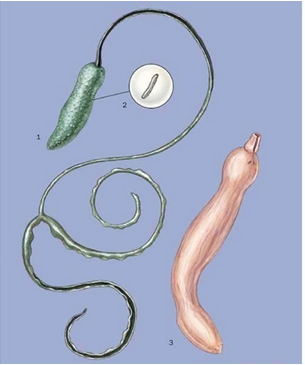Environmentally Determined Sex
in Marine Worms
Biology 342
Fall 2014
Mical Yohannes and Patrick Shan
Reed College
Phylogeny
Phylogeny is the evolutionary history detailing the development of a behavioral trait in a species.
Comparisons to Members of the Same Class Echiura
There are currently 150 known species of Echiura. Bonellia was first identifies as a member of the Echiura, which is a group of marine spoonwoms, due to their affinity for setting in U-shaped burrows, and was later confirmed to display genetic similarites to Echiura. There are 3 key features that differentiate Bonellia viridis from other species of Echiura. Bonellia viridis exhibit environmental sex determination while other species of Euchiura are simultaneous hermaphrodites.Bonellia also have a bright green skin, exhbit extreme sexual dimorphism between the sexes, and have a long probiscus(Figure 1), characteristics that are not seen in other Echiura.
Figure 1. 1) Mature female Bonellia viridis. 2) Mature male Bonellia viridis. 3) Hermaphroditic spoonworm
Comparisons to Members of the Same Genus Osedax
Members of the Osedax genus, whose name is Latin for “bone eating”, are defined by their ability to bore into the bones of deceased marine organism. There are 17 known species of Osedax (Rouse, 2009) and they are found in both shallow and deep waters of the Atlantic and Pacific Oceaans. However, it is unknown if they specialize in colonizing only whales given how Osedax are found primarily on whale bones despite how whales skeletons are sparsely located on the ocean floor. While Osedax were able to successfully colonize cow bones, the low likehood of finding terrestrial bones in the ocean suggests that it is unlikely that Osedax are generalists. (Jones 2008)
However, evolutionary history suggests that Osedax originally specialize in colonizing skeletons of marine birds. Osedax were thought to have evolved alongside whales 30-40 million years ago. However, the discovery of boreholes in penguin bones from about 30 million years ago reveal that Osedax were able to colonize marine birds, so they may have evolved long before whales (Kaplan, 2010). Further research is needed to understand why the diet of Osedax have focused exclusively on whales in the modern era.
Figure 2. 30 milion year old marine bird found with Osedax boreholes.
The narrowing of the available food sources over time for Osedax may have reproductive implications that may help explain why larvae are born sexually undifferentiated. If Osedax are forced to rely on a large meal between periods of starvation, they may have evolved to prioritize finding food, and thus, creating mostly females. When stable food sources have been acquired., then they can foucs on reproduction by creating males. The diversity in available food sources would certainly help to explain this process. Like Echiura, other related species do not exhibit environmentally determined sex, and further studies are needed to understand how this trait has evolved in these two species. They both belong to the genus of annelids, however, there is not a clear common ancestor that may explain the prevalence of this trait.
